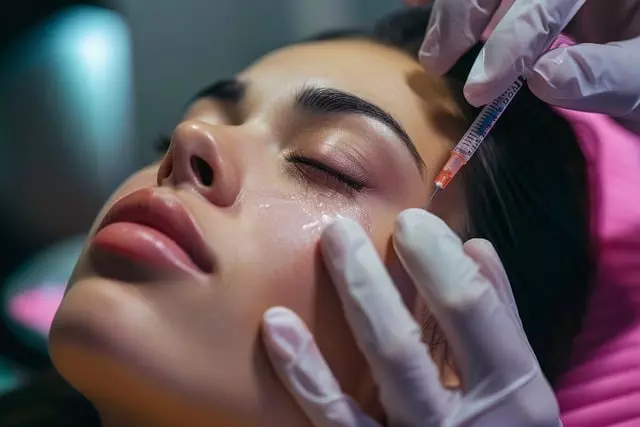Botox for facial contouring is a non-surgical procedure using botulinum toxin (Botox) to relax muscles around cheeks and jawlines, temporarily smoothing wrinkles and defining bone structure. Ideal candidates have mild to moderate concerns, realistic expectations, and good health. The quick, 15-30 minute process causes minimal downtime, with results typically lasting 3-6 months. While generally safe, rare adverse reactions may occur; post-procedure care includes avoiding strenuous activities and following provider recommendations for touch-ups every 3-6 months to maintain results.
“Discover the transformative power of Botox for achieving seamless cheek and jawline contouring. This non-invasive procedure is revolutionizing cosmetic treatments by offering a subtle yet effective way to sculpt facial features. In this comprehensive guide, we explore the science behind Botox’s ability to redefine your face, its numerous benefits, and who makes an ideal candidate. From understanding the technique to addressing potential risks, you’ll find everything you need to know about Botox for facial contouring.”
Understanding Facial Contouring with Botox

Facial contouring using Botox has emerged as a popular non-surgical aesthetic procedure, allowing individuals to achieve defined cheekbones and slimmer jawlines. This technique involves strategically injecting Botox into specific muscle groups responsible for facial expressions, particularly those around the cheeks and jaw. By temporarily paralyzing these muscles, Botox can create the illusion of structural changes, highlighting the natural bone structure and resulting in a more chiseled appearance.
Understanding the science behind this procedure is key to demystifying its effectiveness. Botox, derived from a toxin produced by bacteria, works by blocking nerve signals that cause muscle contraction. In the context of facial contouring, this means reducing the prominence of certain muscles, leading to a reshaped and more sculpted visage. The precision required for this process ensures minimal discomfort and a natural-looking enhancement, making it an appealing option for those seeking subtle yet impactful changes.
The Science Behind Botox for Cheeks and Jawline

Botox for facial contouring, particularly on the cheeks and jawline, is a non-invasive procedure that leverages the power of botulinum toxin (Botox). This toxin relaxes muscles by blocking nerve signals, which can lead to significant changes in facial structure over time. When injected into specific muscle groups around the cheeks and jawline, Botox effectively smoothens out wrinkles, reduces the appearance of bone structure, and provides a more defined contour.
The science behind this procedure is rooted in understanding facial musculature and how it contributes to both aesthetic appeal and functional movements. By targeting muscles like the masseter (responsible for chewing) and the temporal (involved in frowning and squinting), Botox can prevent overactivity, resulting in a more balanced and sculpted look. This technique allows for precise adjustments, ensuring natural-looking results that enhance one’s features rather than alter them drastically.
Benefits of Using Botox for Non-Surgical Contouring

Botox for facial contouring, specifically targeting the cheeks and jawline, offers a multitude of benefits as a non-surgical procedure. It provides a subtle yet effective way to enhance facial features without the need for invasive surgery or extensive downtime. One of the key advantages is its ability to reduce the appearance of fine lines and wrinkles, creating a more defined and chiselled look around the cheeks and jaw. This natural-looking enhancement can boost self-confidence and provide a youthful, refreshed appearance.
Additionally, Botox contouring is a highly versatile approach, allowing for precise adjustments to achieve the desired effect. It’s an excellent choice for those seeking a temporary yet noticeable change, as the effects typically last between 3-6 months. This procedure also carries minimal risks compared to surgical alternatives, making it a popular and safe option for individuals aiming to improve their facial contouring without extensive medical intervention.
Candidate Selection for Cheek and Jawline Contouring

When considering Botox for cheek and jawline contouring, it’s crucial to understand that candidate selection is a critical step in achieving optimal results. The ideal candidates are individuals who have mild to moderate concerns regarding their facial structure, such as rounded cheeks or a square jawline. It’s important to have realistic expectations; while Botox can enhance and define these features, it won’t drastically alter one’s face. Candidates should be in good overall health, with no active infections or autoimmune disorders, as these conditions may impact the procedure’s effectiveness and recovery.
During the consultation, a qualified healthcare provider will assess your specific concerns, review your medical history, and discuss your goals. They’ll evaluate whether Botox for facial contouring aligns with your expectations and is suitable for your unique anatomy. This process ensures that you receive a personalized treatment plan tailored to enhance your natural beauty rather than dramatically transforming it.
Procedure Overview: Step-by-Step Guide

Botox for facial contouring, specifically targeting the cheeks and jawline, has emerged as a popular non-surgical aesthetic procedure. The process involves injecting Botox into specific muscles to temporarily paralyze them, thereby reducing the appearance of unwanted facial lines and defining cheekbones and jawlines. This minimally invasive technique offers a natural-looking enhancement without incisions or extensive recovery periods.
The step-by-step guide begins with a consultation where a trained professional assesses your facial structure and identifies the muscle groups to target. Using a fine needle, Botox is then precisely injected into the selected areas, often including the masseter (jaw) muscles and certain cheek muscles. The procedure is usually quick, taking around 15-30 minutes, and minimal downtime is experienced by most patients. Swelling and redness may occur but typically subside within a few days, leaving you with a more contoured and balanced facial appearance.
Potential Risks, Side Effects, and Recovery

Botox for facial contouring, particularly on the cheeks and jawline, has become a popular non-surgical aesthetic procedure. However, like any medical treatment, it’s crucial to be aware of potential risks and side effects. While Botox is generally safe when administered by a qualified professional, there are some considerations. Common temporary side effects may include redness, swelling, bruising, and discomfort at the injection sites. These usually subside within a few days.
In rare cases, more serious adverse reactions can occur, such as difficulty swallowing or breathing, which require immediate medical attention. It’s important to remember that recovery time varies from person to person. Some individuals may experience subtle changes right away, while others might take up to several weeks to see the full effect. Following post-procedure instructions carefully, including avoiding strenuous activities and certain medications, can help speed up recovery and minimize potential risks associated with Botox for facial contouring.
Maintenance and Follow-up Care After Treatment

After receiving Botox for cheek and jawline contouring, proper maintenance and follow-up care are essential to maximize results and ensure a smooth recovery. It’s crucial to avoid strenuous activities and excessive facial expressions for the first few days following treatment, as this can affect the product’s effectiveness and potentially cause temporary discomfort or bruising. Staying hydrated and applying gentle, fragrance-free moisturizers can help maintain skin health and reduce any dryness that may occur.
Regular follow-up appointments with a qualified provider are vital to assess the progression of results and address any concerns. They can guide you on touch-up treatments if needed, typically every 3-6 months, depending on individual factors. Following their advice on post-treatment care will ensure your skin heals optimally, allowing you to enjoy the desired facial contouring for longer with minimal side effects.
